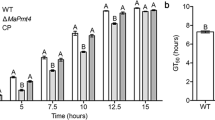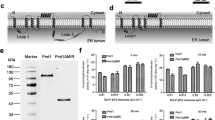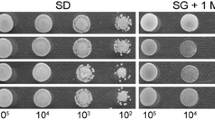Abstract
In fungi, O-mannosylation is one type of conserved protein modifications that add the carbohydrate residues to specific residues of target proteins by protein O-mannosyltransferases. Previously, three members of O-mannosyltransferases were identified in Magnaporthe oryzae, with MoPmt2 playing important roles in fungal growth and pathogenicity. However, the biological roles of the rest Pmt proteins remain unclear. In this study, to understand if O-mannosyltransferases are crucial for fungal pathogenicity of M. oryzae, the Pmt-coding genes MoPmt1 and MoPmt4 were separately disrupted and their roles in pathogenesis were analyzed. Of the two genes, only MoPmt4 is specifically required for full virulence of M. oryzae. Deletion of MoPmt4 resulted in defects on radial growth, with more branching hyphae and septa as compared to Guy11. The MoPmt4 mutant was severely impaired not only in conidiation, but also in both penetration and biotrophic invasion in susceptible rice plants. This mutant also had defects in suppression of host-derived ROS-mediated plant defense responses that might be ascribed from the reduced activities of extracellular enzymes. Furthermore, like their fungi counterparts, MoPmt4 localized in the ER and had O-mannosyltransferase activity. Domain disruption analysis indicated that mannosyltransferase activity regulated by PMT domain of MoPmt4 is crucial for fungal development and pathogenicity of M. oryzae. Taken together, these data suggest that MoPmt4 is a protein O-mannosyltransferase essential for fungal development and full virulence of M. oryzae.










Similar content being viewed by others
References
Apostol I, Heinstein PF, Low PS (1989) Rapid stimulation of an oxidative burst during elicitation of cultured plant cells: role in defense and signal transduction. Plant Physiol 90:109–116
Carroll AM, Sweigard JA, Valent B (1994) Improved vectors for selecting resistance to hygromycin. Fungal Genet Newsl 41:22
Chi M-H, Park S-Y, Kim S, Lee Y-H (2009) A novel pathogenicity gene is required in the rice blast fungus to suppress the basal defenses of the host. PLoS Pathog 5:e1000401
Dean R, Van Kan JAL, Pretorius ZA, Hammond-Kosack KE, Di Pietro A, Spanu PD et al (2012) The Top 10 fungal pathogens in molecular plant pathology. Mol Plant Pathol 13:414–430
Derkx PM, Madrid SM (2001) The foldase CYPB is a component of the secretory pathway of Aspergillus niger and contains the endoplasmic reticulum retention signal HEEL. Mol Genet Genomics 266:537–545
Ebbole DJ (2007) Magnaporthe as a model for understanding host-pathogen interactions. Annu Rev Phytopathol 45:437–456
Egan MJ, Wang Z-Y, Jones MA, Smirnoff N, Talbot NJ (2007) Generation of reactive oxygen species by fungal NADPH oxidases is required for rice blast disease. Proc Natl Acad Sci U S A 104:11772–11777
Fernandez-Alvarez A, Elias-Villalobos A, Ibeas JI (2009) The O-mannosyltransferase PMT4 is essential for normal appressorium formation and penetration in Ustilago maydis. Plant Cell 21:3397–3412
Girrbach V, Strahl S (2003) Members of the evolutionarily conserved PMT family of protein O-mannosyltransferases form distinct protein complexes among themselves. J Biol Chem 278:12554–12562
Gonzalez M, Brito N, Frias M, Gonzalez C (2013) Botrytis cinerea protein O-mannosyltransferases play critical roles in morphogenesis, growth, and virulence. PLoS One 8:e65924
Goto M, Harada Y, Oka T, Matsumoto S, Takegawa K, Furukawa K (2009) Protein O-mannosyltransferases B and C support hyphal development and differentiation in Aspergillus nidulans. Eukaryot Cell 8:1465–1474
Guo M, Guo W, Chen Y, Dong S, Zhang X, Zhang H et al (2010) The basic leucine zipper transcription factor Moatf1 mediates oxidative stress responses and is necessary for full virulence of the rice blast fungus Magnaporthe oryzae. Mol Plant Microbe Interact 23:1053–1068
Guo M, Chen Y, Du Y, Dong Y, Guo W, Zhai S et al (2011) The bZIP transcription factor MoAP1 mediates the oxidative stress response and is critical for pathogenicity of the rice blast fungus Magnaporthe oryzae. PLoS Pathog 7:e1001302
Guo M, Gao F, Zhu X, Nie X, Pan Y, Gao Z (2015) MoGrr1, a novel F-box protein, is involved in conidiogenesis and cell wall integrity and is critical for the full virulence of Magnaporthe oryzae. Appl Microbiol Biotechnol 99:8075–8088
Guo M, Tan L, Nie X, Zhu X, Pan Y, Gao Z (2016a) The Pmt2p-mediated protein O-mannosylation is required for morphogenesis, adhesive properties, cell wall integrity and full virulence of Magnaporthe oryzae. Front Microbiol 7:630
Guo M, Zhu X, Li H, Tan L, Pan Y (2016b) Development of a novel strategy for fungal transformation based on a mutant locus conferring carboxin-resistance in Magnaporthe oryzae. AMB Express 6:57
Guo M, Tan L, Nie X, Zhang Z (2017) A class-II myosin is required for growth, conidiation, cell wall integrity and pathogenicity of Magnaporthe oryzae. Virulence 8(7):1335–1354
Harries E, Gandia M, Carmona L, Marcos JF (2015) The Penicillium digitatum protein O-mannosyltransferase Pmt2 is required for cell wall integrity, conidiogenesis, virulence and sensitivity to the antifungal peptide PAF26. Mol Plant Pathol 16:748–761
Howard RJ, Valent B (1996) Breaking and entering: host penetration by the fungal rice blast pathogen Magnaporthe grisea. Annu Rev Microbiol 50:491–512
Howard RJ, Ferrari MA, Roach DH, Money NP (1991) Penetration of hard substrates by a fungus employing enormous turgor pressures. Proc Natl Acad Sci USA 88:11281–11284
Jeon J, Goh J, Yoo S, Chi M-H, Choi J, Rho H-S et al (2008) A putative MAP kinase kinase kinase, MCK1, is required for cell wall integrity and pathogenicity of the rice blast fungus, Magnaporthe oryzae. Mol Plant Microbe Interact 21:525–534
Le THT, Oki A, Goto M, Shimizu K (2018) Protein O-mannosyltransferases are required for sterigmatocystin production and developmental processes in Aspergillus nidulans. Curr Genet. https://doi.org/10.1007/s00294-00018-00816-x
Lehle L, Strahl S, Fau-Tanner W, Tanner W (2006) Protein glycosylation, conserved from yeast to man: a model organism helps elucidate congenital human diseases. Angew Chem Int Ed Engl 5:6802–6818
Loibl M, Strahl S (2013) Protein O-mannosylation: what we have learned from baker’s yeast. Biochim Biophys Acta 1833:2438–2446
Lommel M, Strahl S (2009) Protein O-mannosylation: conserved from bacteria to humans. Glycobiology 19:816–828
Lommel M, Schott A, Jank T, Hofmann V, Strahl S (2011) A conserved acidic motif is crucial for enzymatic activity of protein O-mannosyltransferases. J Biol Chem 286:39768–39775
Matar KAO, Chen X, Chen D, Anjago WM, Norvienyeku J, Lin Y et al (2017) WD40-repeat protein MoCreC is essential for carbon repression and is involved in conidiation, growth and pathogenicity of Magnaporthe oryzae. Curr Genet 63:685–696
Maundrell K (1993) Thiamine-repressible expression vectors pREP and pRIP for fission yeast. Gene 123:127–130
Money NP (1989) Osmotic pressure of aqueous polyethylene glycols: relationship between molecular weight and vapor pressure deficit. Plant Physiol 91:766–769
Mouyna I, Kniemeyer O, Jank T, Loussert C, Mellado E, Aimanianda V et al (2010) Members of protein O-mannosyltransferase family in Aspergillus fumigatus differentially affect growth, morphogenesis and viability. Mol Microbiol 76:1205–1221
Nurnberger T, Brunner F, Kemmerling B, Piater L (2004) Innate immunity in plants and animals: striking similarities and obvious differences. Immunol Rev 198:249–266
Olson GM, Fox DS, Wang P, Alspaugh JA, Buchanan KL (2007) Role of protein O-mannosyltransferase Pmt4 in the morphogenesis and virulence of Cryptococcus neoformans. Eukaryot Cell 6:222–234
Prill SK, Klinkert B, Fau-Timpel C, Timpel C, Fau-Gale CA, Schroppel K, Ernst KF, Ernst JF (2005) PMT family of Candida albicans: five protein mannosyltransferase isoforms affect growth, morphogenesis and antifungal resistance. Mol Microbiol 55:546–560
Sambrook J, Russell DW (2001) Molecular cloning: a laboratory manual. Cold Spring Harbor Laboratory Press, Cold Spring Harbor
Song W, Dou X, Qi Z, Wang Q, Zhang X, Zhang H et al (2010) R-SNARE homolog MoSec22 is required for conidiogenesis, cell wall integrity, and pathogenesis of Magnaporthe oryzae. PLoS One 5:e13193
Strahl-Bolsinger S, Gentzsch M, Tanner W (1999) Protein O-mannosylation. Biochim Biophys Acta 1426:297–307
Talbot NJ (2003) On the trail of a cereal killer: Exploring the biology of Magnaporthe grisea. Annu Rev Microbiol 57:177–202
Wang Y, He D, Chu Y, Zuo Y-S, Xu X-W, Chen X-L et al (2016) MoCps1 is important for conidiation, conidial morphology and virulence in Magnaporthe oryzae. Curr Genet 62:861–871
Willer T, Valero MC, Tanner W, Cruces J, Strahl S (2003) O-mannosyl glycans: from yeast to novel associations with human disease. Curr Opin Struct Biol 13:621–630
Willer T, Brandl M, Sipiczki M, Strahl S (2005) Protein O-mannosylation is crucial for cell wall integrity, septation and viability in fission yeast. Mol Microbiol 57:156–170
Xu Y-B, Li H-P, Zhang J-B, Song B, Chen F-F, Duan X-J et al (2010) Disruption of the chitin synthase gene CHS1 from Fusarium asiaticum results in an altered structure of cell walls and reduced virulence. Fungal Genet Biol 47:205–215
Yan X, Li Y, Yue X, Wang C, Que Y, Kong D et al (2011) Two novel transcriptional regulators are essential for infection-related morphogenesis and pathogenicity of the rice blast fungus Magnaporthe oryzae. PLoS Pathog 7:e1002385
Yi M, Chi MH, Khang CH, Park SY, Kang S, Valent B et al (2009) The ER chaperone LHS1 is involved in asexual development and rice infection by the blast fungus Magnaporthe oryzae. Plant Cell 21:681–695
Acknowledgements
Thanks are given to Dr. S. Strahl-Bolsinger for providing S. pombe strains and to Dr. Susan Forsburg for providing the plasmid. This work was supported by the National Natural Science Foundations of China (Grant No: 31671976 to MG; Grant No: 31101401 to MG), the Key Grant for Excellent Young Talents of Anhui Higher Education Institutions (gxyqZD2016037 to MG), Natural Science Foundations of Anhui province (Grant No: 1608085QC49 to MG), the Foundation for the Excellent Talents of Anhui Agricultural University (Grant No: RC2015002 to MG), and the Anhui Agricultural University Postgraduate Innovation Foundation (Grant No. 2018yjs-4 to RP). The Zhang laboratory research was supported by the National Science Foundation for Distinguished Young Scholars of China (Grant No. 31325022 to ZZ).
Author information
Authors and Affiliations
Contributions
Conceived and designed the experiments: M. Guo and Z. Zhang. Performed the experiments: Y. Pan, R. Pan, and L. Tan. Analyzed the data: M. Guo and R. Pan. Wrote the paper: M. Guo.
Corresponding author
Ethics declarations
Conflict of interest
The authors declare that the research was conducted in the absence of any commercial or financial relationships that could be construed as a potential conflict of interest.
Additional information
Communicated by M. Kupiec.
Electronic supplementary material
Below is the link to the electronic supplementary material.
Rights and permissions
About this article
Cite this article
Pan, Y., Pan, R., Tan, L. et al. Pleiotropic roles of O-mannosyltransferase MoPmt4 in development and pathogenicity of Magnaporthe oryzae. Curr Genet 65, 223–239 (2019). https://doi.org/10.1007/s00294-018-0864-2
Received:
Revised:
Accepted:
Published:
Issue Date:
DOI: https://doi.org/10.1007/s00294-018-0864-2




